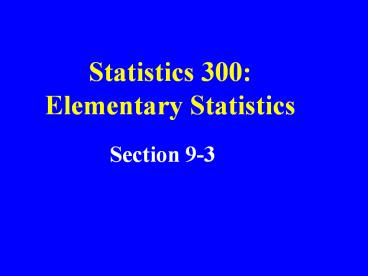Statistics 300: Elementary Statistics - PowerPoint PPT Presentation
Title:
Statistics 300: Elementary Statistics
Description:
Statistics 300: Elementary Statistics Section 9-3 Section 9-3 concerns Confidence Intervals and Hypothesis tests for the difference of two means, (m1 m2 ... – PowerPoint PPT presentation
Number of Views:110
Avg rating:3.0/5.0
Title: Statistics 300: Elementary Statistics
1
Statistics 300Elementary Statistics
- Section 9-3
2
Section 9-3 concernsConfidence
IntervalsandHypothesis tests forthe difference
of two means, (m1 m2)
3
What is the variance of
- Apply the new concept here also
4
Application Use sample values
5
Alternative approach when two samples come from
populations with equal variances
homogeneous variances or homoscedastic
6
When samples come from populations with equal
variances
7
When samples come from populations with equal
variances
8
Alternative notation for thepreceding formula
9
When doing confidence intervalsof hypothesis
tests involving (m1 m2) one must first decide
whether the variances aredifferent or the
same,heterogeneous or homogeneous.
10
If the variances are different(heterogeneous),
then use thefollowing expression as partof the
confidence interval formulaor the test statistic
11
If the variances are the same(homogeneous), then
use thisalternative expression as partof the
confidence interval formulaor the test statistic
12
When the variances are pooledto estimate the
common (homogeneous) variance, then the degrees
of freedom for both samples are also pooled by
adding them together.
13
Application to CI(m1 - m2)
14
Application to CI(m1 - m2)when variances are
different
In this case, the degrees of freedom for t will
be the smaller of the two sample degrees of
freedom.
15
Application to CI(m1 - m2)when variances are the
same
In this case, the degrees of freedom for t will
be the sum of the two sample degrees of freedom.
16
Tests concerning (m1 - m2)Test Statistic
17
Test statistic for (m1 - m2)when variances are
different
In this case, the degrees of freedom for t will
be the smaller of the two sample degrees of
freedom.
18
Test statistic for (m1 - m2)when variances are
the same
In this case, the degrees of freedom for t will
be the ssum of the two sample degrees of freedom.
19
Section 9-3Handling Claims / Hypotheses
- Write the claim in a symbolic expression as
naturally as you can - Then rearrange the expression to have the
difference between the two means on one side of
the relational operator (lt gt )
20
Section 9-3Handling Claims / Hypotheses
- Statement Mean 2 is less than four units more
than Mean 1 - So
- Rearrange
- H0
- H1
21
Section 9-3Handling Claims / Hypotheses
- Statement On average, treatment A produces 18
more than treatment B - So
- Rearrange
- H0
- H1































